Abstract
This research project was designed to uncover the real perception of safety in Hong Kong International Schools among parents, teachers, administrators and students. To this end a literature review was done, which showed that there is certainly a rising trend world-wide towards violence in schools. It is with this in mind that I decided to research the perceptions and the reality of safety in the International schools in Hong Kong. To this end the literature was searched and then a survey using a very large sample of parents plus an in depth interview of four security managers was conducted to ascertain the current status of safety in our schools versus the perception of safety in our schools.
Introduction
Background of Research
School is supposed to be the safest place for students to study, for teachers to teach and for staff to work. However, it seems that it is no longer the safest place at all, because of the rising rate of school violence happening around the world. School security is therefore becoming a major concern for teachers, administrators, students, parents and government. This may be especially true of International schools, where expatriate parents on business or diplomatic missions send their children, since these are high profile targets, because the children and parents are financially well off.
“In Japan, school violence against pupils, staff or property was reported in 2% of elementary schools, 30% of middle schools and 37% of high school. In France, a national survey in 1998 – 1999 of violence in middle and secondary schools reported 88,500 incidents among 3.5 million students. The most common was verbal abuse; followed by theft, attempted robbery and physical violence. In the U.S.A., for 2001-2002 there were 5 violent deaths in schools. In the UK, statistics showed nearly 7,000 incidents of school violence and threatening behaviors were reported”. (Shaw, Margaret 2001)
In Hong Kong, a pressing issue on campuses on May 19, 2004 was the alarming culture of violence. The Education and Manpower Bureau of Hong Kong asked 1,276 primary and secondary schools to report on the situation of school violence from September 2003 to February 2004. The survey revealed that there were 830 incidents of violence in schoolyards over the previous six months, with 460 follow-up cases. The situation of school violence is most serious in the Island District. On average, there is one incidence of school violence for every 500 students. For Southern, Kwung Tong, Tuen Mun and Kowloon City Districts, there is one incidence of school violence for every 1,000 students. (The Hong Kong Federation of Youth Groups, 2009)
The International Situation
A most serious incident happened on April 16, 2007, when there were “at least 32 dead after the Virginia Tech University shooting. It sent shockwaves through the college and university community across America. Not only was it the most devastating violent episode ever to occur at an institution of higher learning, it was the largest mass shooting of any kind in the nation’s history.” (FOXNews.com 2009) The sense of school security that characterized most campuses was suddenly shaken even more than ever before. The incident at Columbine High school began a rash of copycat shootings in the United States, but none so devastating as that one. Marc Lepine killed seventeen women students in Montreal at École Polytechnique (BBC News On line 2009) in the early nineties and then there was a shooting at Dawson College (citation) some years later, but Canada has had relatively few such cases, which Canadians attribute to their strict gun laws. The truth is that there have been incidents of school violence in most countries around the world.
The Risk in Hong Kong
Although the risk of shooting in any particular school in Hong Kong is markedly lower due to the high restriction on possession of guns, it doesn’t mean that Hong Kong can ignore the need for risk management in schools. Apart from school violence, vandalism in schools and terrorist threats to schools, such things as bomb threats, biological & chemical threats etc., also impact school security. For an example, in the UK, vandalism in schools yearly costs this country an estimated £83 million. (UK HomeOffice Crime Reduction 1009) This excludes the social costs of inconvenience, depression, despair and anger suffered by those who have to use vandalized buildings. With the opportunities presented by grant-maintained status, many head teachers now have an added responsibility for the upkeep of their school. They need to be aware of the most effective strategies for minimizing vandalism, where to target their resources and how to cut their costs. (Davies and Stevens 1994) With increasing incidence and decreasing resources, the project manager carries a heavy responsibility for maintaining health and safety in the schools.
In Hong Kong, there are two different types of Primary and Secondary schools: local traditional schools and International schools. The International Schools in Hong Kong face a bigger challenge with security systems than the local schools, because the majority of their students are from the foreign countries, The international schools face a greater potential for school violence and vandalism due to the different cultures being gathered in the same community, conflicts are main sources of violence and vandalism. The International Schools in Hong Kong must respond to campus security proactively to make everyone aware of potential risks in order to protect the lives of all students, faculty and staff; and to protect the campus property as well. Thus, it is prudent that schools should take reasonable care to ensure the safety of their students, faculty and staff as well as all visitors. Are security measures for the international schools in Hong Kong sufficient or not? Are there any risk management programs implemented to prevent problems and to insure rapid response to any situation? Are the students, parents and faculty staff living, working and studying in a safe environment? The purpose of this research is to find out these answers.
Aims and Objectives
Aim of the Research
The purpose of this research is to explore the awareness of risk management for the Security of International Schools in Hong Kong to help inform Administrators so that they may take a proactive approach to review design and implement the risk management program for security system and security measures in order to prevent and avoid the violence and vandalism in schools. The potential barriers to the implementation of risk management programs for security measures will also be discussed in this research.
Objectives
In order to fulfill the research aim, the following objectives are set:
- To understand the impact of violence at schools in foreign countries
- To compare the security measures and the risk management for each of the selected International School.
- To investigate the confidence of parents in the security measures in each of the selected International Schools;
- To evaluate the adequacy the school security systems and risk management measures for International Schools in Hong Kong.
- To understand the impact of violence at schools in foreign countries
Methodology
Both structured interviews and the distribution of a questionnaire survey will be used in this project for the primary research. These will be analyzed and conclusions drawn from them concerning the current perceptions of parents, teachers, staff and security professions. This will be compared and contrasted with the information gained from the literature review and conclusions will be drawn as to the final import and meaning. This should lead to ideas concerning future research.
Structured interviews
At least 4 Security Managers from different International schools have been invited for face-to-face interviews to seek their opinions on the level and efficacy of the security system for the International School in Hong Kong and the risk assessment of their campus as well as the existing security measures of the campus.
The targeted international schools will be:
- Hong Kong International School (in Hong Kong Island)
- Canadian International School (in Hong Kong Island)
- French International School (in Hong Kong Island)
- Australian International School (in Kowloon)
Questionnaire Survey
200 sets of questionnaires will be distributed to pre-selected International Schools in Hong Kong. Parents, faculty and staff are the targeted participants to respond to the questionnaires. Parents, faculty and staff are selected as the targeted people, because Parents are most concerned with the safety of their children at school. Their awareness of security issues will be higher than the administrators’, because they are directly affected by these issues and they have the most concern for their own children. Also, administrators may know more and this difference makes the parents even more concerned for lack of direct knowledge. They have a concern about school’s solutions and precautionary measures to protect their children, especially when incidents from around the world are published in the international news. Therefore, their opinions may reflect a more realistic assessment of overall perception of the safety of these schools.
Faculty and staff are working there and their safety is equally important, but their opinions will only reflect how they feel about their own safety and that of the students. Unless the staff members have children in the school, it will not be likely that they will respond with equal concerns with parents. In addition, they are also in more direct contact with school officials and security people, which may make their perception of safety more positive.
Literature Sources
The information relevant to this research project was obtained from variety of resources:
E-journals
University of South Australia Online Library Database
EBSCO database through University library: Peer reviewed journals e.g. Simister T. (2000), Risk Management: The Need to Set Standards, Emerald Management Reviews Database , Vol. 8, Issue 4
Edwards, P & Bowen, P. (2005), Risk Management in Project Organizations, First Edition, Butterworth Heinemann
Relevant Internet Sites and Government Reports
Newspaper and Magazine Articles and Reports
Literature Review
Introduction
In order to explore the awareness of risk management for the security of International Schools in Hong Kong, the current literature was searched for relevant information, such as the definitions of risk, risk management and the processes used to assess, mitigate, respond to and prevent risk.
Definition of Risk Management
Risk management is, essentially, the same across all domains in its basic characteristics. The risks, causes and effects are different, but all risk management fits the basic definitions. Some of the most succinct definitions are in the domains of engineering and software development.
Project risk management can be defined as; “…. the systematic processes of identifying and responding to project risk … [throughout the project life-cycle]”. (Wang, John X. and Roush, Marvin L., 2000) It includes maximizing the results of positive events and minimizing the consequences of adverse events. The AMP book defines risk as; “Factors that may cause a failure to meet the project’s objective …or limits the achievement of the objective as defined at the outset of the project.” (Arto, K. A. 2000).
Risk management is loosely defined as a formalized method for controlling uncertainty related to some kind of threat, using procedures previously documented, including risk assessment, management strategies development and risk mitigation employing the resources available to management. The strategies may include reassigning the risk, avoiding the risk, mitigating the negative effect of the risk, and simply dealing with the consequences of the risk. Risk management includes identification, analysis, and reduction or elimination of loss to an organization or individual. Many tools and techniques can be used, including insurance, to manage a wide variety of risks. Some traditional risk management strategies are focused on risks stemming from physical or legal causes (e.g. natural disasters or fires, accidents, ergonomics, death and lawsuits). (ISO 31000, 2009).
Risk management aims to reduce different risks to an acceptable as defined by the clients or organization. It can include threats caused by environment, technology, human psychology and sociology, organizations and political ideology. Risk covers all organizational activities and it is part of all management levels.
Risk management has become a major part of every organization’s activities and its objective is to help all other management activities to reach the organization’s goals efficiently. Risk management is a continuous process that responds directly to the changes of the organization’s internal and external environment. In reality the environment must be monitored continuously for the identification and control of risks.
Risk management is, essentially, a process that is used to identify potential risks and liabilities that could result in some kind of loss for both public and private organizations (monetary, property, etc.). Risk management strategies vary depending on the nature of the organization, including management style and organizational goals (Conrow, Edmund H. Ph.D. 2000). There are four basic steps in the risk management process that apply to most organizations.
This includes:
- Identify the risk
- Assess the severity and likelihood of risk
- Create a response to particular risks
- Control the risk (Tchankova, Lubka, 2002)
Types and Scope of Risk
Scope of the Problem
“It is difficult to compare levels of school-related violence among countries because:
- Many countries do not collect national information about reported schoolviolence.
- Countries use different definitions of school violence.
- Differences in language and culture can make it difficult to compare even similar behaviors among countries.
- Within most countries, reporting practices can vary a great deal.
- Sources range from small, self-report school studies to area surveys of victimization to police or school reports of incidents.
- Sources vary across different ages of pupils, types of school, and periods of time.
- Schools often are reluctant to admit there are problems.
- Peer pressures intimidate students from reporting incidents. “ (Shaw, Margaret 2001)
Types of Risks
Generally, there are three types of risk, they include:
Opportunity-based Risk
There are two main aspects of opportunity-based risks; the first one is risks associated with not taking an opportunity and those associated with taking an opportunity.
Uncertainty-based Risk
Uncertainty-based risk is the risk associated with unknown and unexpected events. This type of risk has attracted more recognition as a result of events such as Y2K, September 11 and recent natural disasters such as the Asian tsunami.
Hazard-based Risk
Hazard-based risk is the risk associated with a source of potential harm or a situation with the potential to cause harm. This is the most common one associated with business risk management, as addressed by occupational health and safety programs. Hazard-based risks include:
- Physical hazards : noise, temperature or other environmental factors
- Chemical hazards: storage and/or use of flammable, poisonous, toxic or carcinogenic chemicals
- Biological hazards: viruses, bacteria, fungi and other organisms
- Ergonomic hazards: poor workspace design, layout or equipment
- Psychological hazards: bullying, sexual discrimination, burnout, abuse
Risk Management Process Identify the Risks
Identification is the first step in risk management. This is not the time to try to assess risks, but it is important to identify all possible risks. School violence, bullying, vandalism, terrorist threats etc. are the most important risks that would impact the operations of school security, so these are the first to consider.
For example, antisocial behavior by students often leads to violence. In many countries this has become a major concern for educators and politicians. Over the last several years, much research has been done in an attempt to identify the emotional and behavioral factors that might be markers of students at high risk of such conduct. Antisocial behavior results from an individual’s inability to respect the rights of others (assault, vandalism, setting fires, theft), conform to social norms (prolonged runway, crime), or meet the expectations of authorities (opposition, defiance, arguing) (Frick, 1998)( Smith, Page A. 2005)
For many years, campus crime was hidden, and passed off as youthful pranks or idiosyncratic events, and it still is in many cases today. More recently, however, celebrated cases have drawn attention to the idea that school can be a dangerous environment: professors slain; students murdered at several campuses; stranger and date rapes; aggravated assaults; and the like are in the news everywhere in the world. Wikipedia lists 25 pages of violent events over the las 48 years. Though most listed are in the USA, there are incidents in almost every country in the world, including many considered as very peaceful. It is possible that US incidents predominate in the news, because they are more often reported. Many countries do not look kindly upon what is considered sensationalist journalism. In consideration of the many reports found, after examination, the ratio of incidents was actually quite low when compared to the number of students in school daily around the world. However, such statistics are small comfort to worried parents. Although research has shown that one is far more likely by a huge factor to die in a traffic accident than in an airplane crash, people still fear air travel. This is possibly because almost all air accidents are reported in international news and usually involve multiple injuries and fatalities, while traffic accidents often do not even merit a line on the back page of the local newspapers. Traffic accidents have become an accepted part of our environment.
Now, school violence has becoming a major issue around the world, partly due to the increase in violence in schools, or possibly just the increase in the reporting of violence in the schools. Official sources remain relatively rare, inconsistent and unreliable, as few countries have attempted to collect statistical data about the problem. In fact, some countries actively hide such data. Nevertheless some countries have started collecting data on violent incidents in school in the wake of media or union pressure. A typical incident reported in French Secondary School (Pupils from age 12 upward) 14,780 events reported, of which 4,980 physical violence without weapons, 3,790 insults and threats, 1,707 thefts, 1,757 acts of vandalism, 583 acts of theft with extortion, 475 intrusions by outside elements or 372 cases of violence with knives. A total of 11 cases of possession of firearms were reported and 303 cases of racism for the first term of the 2001-2002 school year. (Debarbieux, Eric 2003)
To tackle the school violence problem, an International Conferences on Violence in Schools began in Paris in 2001, followed by Quebec, in May 2003, the third and fourth conferences to be held in Rio de Janeiro and in the UK. The scientific community has been mobilized around this. The increased violence in schools, which raises questions about “globalization” of school violence and about the link between this violence and “economic globalization” has sensitized the public and parents have become very concerned.
Risk Assessment
Risk needs to be quantified on two frames. The impact of the risk must be assessed and the probability of the risk occurring must be assessed as well. In an ongoing study of forty cases involving school violence or shootings over the last twenty years, the United States Secret Service’s National Threat Assessment Center has found that students who are prone to violence often do not make clear threats to victims or school officials, but instead make their intentions known to peers (Henry, 2000) The notion of psychological profiles” was initially developed as an investigative technique to aid in determining the type” of person most likely to commit a given offense based on inferences from the evidence and/or the subject’s behavior at the scene (Holmes & Holmes, 1996). However, this kind of profiling has been less than useful in school and public settings, as sifting through the entire range of possibilities leads to ignoring current clues in favor of targeting “likely suspects”. (Borum et al 1999) Two approaches can be used for predicting violence: clinical and actuarial (Garb, 1994; Grove and Meehl, 1996). Clinical approaches to violence risk assessment, which is less systematic and less reliable, involve the collection of clinical data, history, and observations coupled with the subjective impressions about whether a person is, or is not, potentially violent. Actuarial approaches to risk assessment are based on mathematical algorithms which yield a statistical probability that a person will or will not be violent. The clinical approach works in most cases. The actuarial approach works over all in a range of cases.
The National School Safety and Security Services has-specific security experience which has allowed them to create a structured, specialized assessment process, “including:
- Analysis of policies, procedures, emergency and crisis guidelines, and other safety-related documents
- Surveys and structured interviews of staff, students, and/or members of the school community
- Crime and discipline data review
- Examination of physical facilities and grounds
- Analysis of related news, crime, and other public information sources
- School-specific analytical methods.”
By using these guidelines, school security in many schools have developed methods for assessing the safety of students, teachers and staff. (Fortin, Laurier 2003)
Risk Response
There are four strategies for responding to a risk:
- Avoid the risk. Do something to remove it.
- Transfer the risk. Make someone else responsible.
- Mitigate the risk. Take actions to reduce the impact or the chance of the risk occurring..
- Accept the risk. The risk might be so small the effort to do anything is not worth.
In response to both the media attention and the growing numbers of violent crimes on campuses, most larger colleges and universities have created a systematically professional public safety department, very similar to state and municipal policing agencies. This includes increased training, the formalizing of arrest powers to officers, and in many cases, granting permission for security officers to carry firearms while on duty.
The establishment of best practices for campus safety and violence prevention is suggested for a prevention program. A set of best practices recommendations were found to be common among 20 previous reports on campus violence produced by work groups and task forces from around the county.
“These include:
- Create an all-hazards Emergency Response plan (ERP)
- Adopt an emergency mass notification and communication system
- Establish a multi-disciplinary team to respond to threads and other dangerous behaviors
- Review and train personnel regarding privacy/information sharing laws and polices such as FERPA and HIPAA
- Have an MOU with local health agencies and other key partners in the community.
- Practice emergency plans and conduct training
- Educate and train students, faculty, and staff about mass notification system and their roles and responsibilities in an emergency
- Educate faculty, staff, and students about recognizing and responding to signs of mental illness and potential threats.
- Conduct risk and safety assessments
- Have an interoperable communication system with all area responders
- Ensure that all responder agencies are trained in the National Incident Management System (NIMS) and the Incident Commend.” (Applied Risk Management 2008) (Davies, Hilary and Stevens, Christopher 1993/1994)
Risk Control
The final step is to continually monitor risks to identify any change in the status, or if they turn into an issue. It is best to hold regular risk reviews to indentify actions outstanding, risk probability and impact remove risks that have passed and identify new risks.
During the past ten years, a tremendous variety of school safety programs and strategies have been described in the literature. These include “Zero-tolerance” Policies, use of cameras and detection devices, attention to the design and use of physical space, and annual safety assessments of the school environment. Recommended long-term prevention strategies include mentor programs, the teaching of conflict solution skill, law related education and character education. (Bowen, Peter J. and Bowen, Paul A. 2005).
Recommendations for Preventing Violence
Having reviewed the best practices recommendations in the literature, recommendations are to create a program for safety and violence prevention. This points out the need for careful and measured planning of campus safety. School safety is not simple or universal: it requires an analysis of each school’s unique situation, character, setting, population, and mission. The recommendations in this report should be considered in the wider area of the school’s approach to prevention and security and should consider the views of a wide range of interested parties in tandem with opinions of professionals and experts. Such collaborative efforts may offer the best security and safety plan for any educational institution. (Lambert, Regina D. and McGinty, Dixie 2001)
It is important for assessments to consider both the positive school safety measures already in place at the time of the evaluation, as well as the areas for continued school safety planning and improvement. School administrators need to assess school safety prior to a crisis. School safety reports stemming from assessments should be submitted in a final written report to school officials.
Primary and secondary schools have unique problems concerning security concepts. The assessments for some schools may result in recommendations for security equipment and/or staffing, but these tools are to supplement, not substitute for, a comprehensive security program. The use of technologically advanced equipment or any other single-approach is not a balanced approach. For example, a camera could be an unnecessary expense, or it could be a key to overall safety, depending upon placement and circumstances.
An assessment of the unique needs of individual schools can help to manage resources effectively. Areas reviewed in a professional school security plan could include:
- School emergency and crisis preparedness planning
- Security crime and violence prevention policies and procedures
- Physical security measures including access control, communications capabilities, intrusion detection systems, perimeter security, after hours security, physical design
- Professional development training and emergency planning
- Support service roles in school safety, security, and emergency planning including facilities operations, food services, transportation services, pupil services, physical and mental health services, technology services, and associated school departments
- School security and school police staffing, operational practices, and related services
- Linking of security with prevention and intervention services
- Personnel and internal security (Trunp, Kenneth, 2009)
Summary of Findings
School violence has become a big problem around the world. According to surveys, the numbers of school violent incidents are rising. Most of the schools in the reports believe that establishing best practices for campus safety and violence prevention is the best way to prevent school violence. Having reviewed the previous literatures, the approach of preventing the school violence is quite similar to the tools of risk management, which is to identify the risk, to assess and control it. Implementation of risk management in school security systems may help the school officers to understand the real situation and set up some policies to prevent the violence, vandalism and terrorist threats in schools. In the meantime, they may able to react to the accidents properly to minimize the damage.
The following table summarizes the findings in the contents of the reviewed reports :
(Werthein, Jorge 2003) (Fishe, Bonnie S. 1995) (Cornell, Dewey G. 2003) (Olsson, Rolf 2008) (O’Neill, Daniel; Fox, James Alan Ph.D.; Depue, Roger Ph.D., & Englander, Elizabeth Ph.D. June 2008) (Parker, David and Mobey, Alison, 2004),
Primary Research Findings
In order to investigate the validity of the information gathered in the review of current literature, primary research consisting of a short questionnaire was distributed to parents with children in the International schools in Hong Kong and a longer, very detailed interview conducted with the security professionals responsible for the safety in four of the Hong Kong’s International schools. These will be compared to discover the difference of perception between the two groups and conclusions will be drawn from this. IN addition, the results of the primary research will be compared with the results of the literature review and the combined conclusions will be drawn from this comparison.
Questionnaire for Parents
A survey was conducted among parents of children in Hong Kong International Schools. The Questionnaire used is in Appendix A. The results and analysis follow here. All questions are on a scale of 1-5 with 5 the strongest agreement. The responses are color coded from left (1) to right (5) The numbers shown indicate the actual number of respondents of the total 650 who responded with that answer. Some respondents declined to answer some of the questions and this is indicated in the totals.
1. School is a safe place for kids to learn.
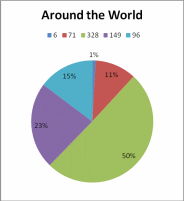
This chart shows that the perception of most Hong Kong parents of children in International schools is that children are not safe in schools around the world. This is probably due to the international news which publicizes all the major incidents, but does not remind readers that these represent a miniscule percentage of schools.

This shows that the perception of safety is a slight bit higher for Hong Kong schools, with fewer choosing 1, but 10% more (25%) choosing 5 (totally agree) Still, half of the responses fall in the low category.
2. School Security related risks are low.
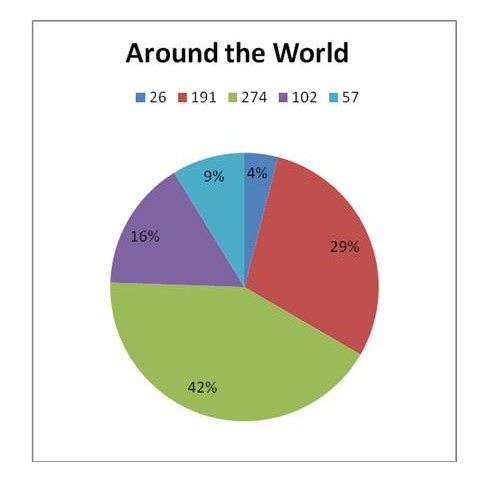
Again, most responses fall in the middle, with fewer than 10% of respondents choosing either totally disagree or agree.
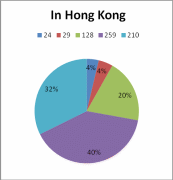
The highest percentage of respondents chose to agree somewhat or even completely that school security risks are low in Hong Kong, with fewer than 10% choosing to totally or even mostly disagree.
3. Violence doesn’t happen in schools

Nearly a third of respondents disagreed totally with this statement, showing that the perception is that violence does happen in schools. Only 4% agreed with this statement, but even that seems high for total agreement with a statement which is clearly wrong. Violence doesn’t happen in schools

It is clear that parents in Hong Kong feel that Hong Kong schools are safer than international schools, since only 5% totally disagreed with this statement and 20% totally agreed that violence doesn’t happen in Hong Kong schools.

In contrast with the previous question, most respondents agreed, with 50% mostly or totally agreeing that terrorism has a large negative impact on schools around the world.

13% totally disagreed that terrorism has a large negative impact on schools in Hong Kong, while 19% totally agreed, but these figures still show more confidence in Hong Kong schools.
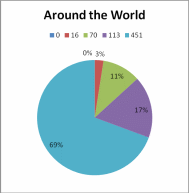
This question shows that most people believe that risk management for security in schools is very important. None disagreed entirely and nearly 70% agreed totally for foreign schools.
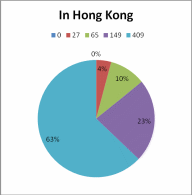
It is interesting to note that no respondents disagreed totally with this statement for Hong Kong schools either, but fewer agreed totally, so the perception that Hong Kong schools are safer is obvious.
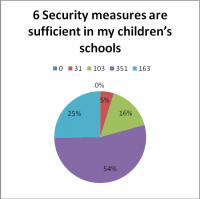
Again, there were no respondents who disagreed with this. However, two respondents did not answer, and only 25% actually totally agreed. The majority felt that they were less sure of the sufficiency of security measures in their children’s schools
7. My children’s school notifies me when any incident relating to security problems occur.
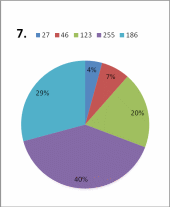
4% of respondents did not believe that they were fully informed, while 13 respondents declined to answer. Only 29% were confident that they were fully informed. 67% of respondents felt less than totally convinced that they were fully informed.
The pattern of responses seems about the same here: Terrorism is considered even less likely in Hong Kong, as is the use of guns, while bullying rates as an even higher danger. Drug use leads next and is followed by assault and theft.
Conclusions from Survey Questionnaire
The survey of parents shows that the parents perceive that there is danger in schools in Hong Kong and around the world. They believe that there is more danger in foreign countries than in Hong Kong. This may be due to the news agencies around the world being somewhat more daring in what they publish. Even though Hong Kong is a Special Administrative Region and separately governed, it is still part of mainland China, and must recognize that it is Chinese policy for newspapers to be reserved in what they publish. We are also cognizant that our population is very large, and news agencies must be responsible and consider carefully the possible reactions to anything they publish. So, to report every incident of violence in this large population would be overly dramatic and it could give a wrong impression of danger. Considering the population size, a few dozen incidents of some minor violence is not a huge thing. However, daily reports of violence would make it look all out of proportion.
Most respondents believe that risk in schools is medium, that security is pretty good even in foreign countries, but more so in Hong Kong. They are, however, aware that violence does occur in schools. The question concerning terrorism could possibly have been better stated, since it is obvious from the responses that parents are really not very concerned about terrorism in schools, but they feel that terrorism has a large negative impact on schools. Perhaps the interpretation is that terrorism, in general, has a negative impact or that terrorism, when it happens, has a large negative impact on schools.
Parents do believe that risk management is important to have in schools, both foreign and in Hong Kong. They do not believe that they are kept fully informed, and many are not aware of a risk management team in their children’s schools. There was a measurable portion of respondents who were not willing to answer questions about their children’s schools’ risk management team or about their opinions of the relative safety of their children in school. This is not surprising, since Hong Kong residents have learned that they should only be critical of government when it is extremely important and when they are part of a large group.
Bullying and drugs seem to be the primary concerns of Hong Kong parents of children in the International schools. Since these families are more affluent than the average family, drugs are a natural fear. People with no money are not often targets by drug dealers, since it is not as profitable. Vandalism and assault are next in the perception of these parents as a danger, while shootings are seen as more of a risk than terrorism, but both are quite low locally. These respondents perceived the dangers from guns and terrorism to be more in foreign countries. When asked about control, the majority of respondents indicated that they see a need to control bullying and drugs in the schools. All dangers were seen as less in Hong Kong than abroad.
Interviews of Security Personnel
A very comprehensive interview was constructed and administered to one manager of school security in each of four Hong Kong international schools. The interviews were in great depot hot explore the real situation in the schools, the perception of the managers of the programs as to their relative efficacy and their perception of the needs of the parents, students, teachers and staff. The actual interview questions which were used are listed in APPENDIX B.
Interview Results
In the charts below, only the lowest to highest responses are shown. Therefore, the viewer might get the impression that some responses are very low, because they look low. In question 1, the lowest response was just under 8 and the highest was 9, so the charting program shows only from 7.5 to 9, saving space, but not including the numbers outside the response range, even though they were available to the respondents. This makes it easy to see the difference, but not easy to understand the level of the responses. The reader should consider the average against the number 1, which is the lowest possibility.
- On a scale of 1-10, with 10 being the highest, please rate the safety level of this school for students, teachers and staff.


Two of the four security specialists rated their school’s safety level at nine and two rated it at eight, so they are all pretty confident that their schools are safe, but see room for improvement.
2.Please rate the following possible threats for which measures have been taken according to your perception of the danger they represent for your school by numbering them from most harm represented to least. You should consider for this question only possible level of harm and not the possibility of its occurrence. Use the number 1 for the worst and each higher number will represent a smaller possible level of harm. (The viewer should remember that 1 is high and 10 is low: that was a miscalculation in creating these interviews.)
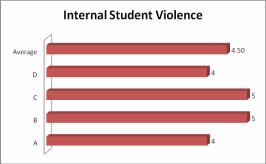
All the specialists saw internal violence of student upon student as a medium sized problem doing less than serious harm.
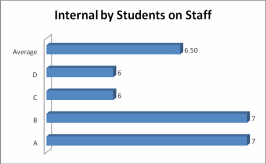
The perception of the damage done by internal violence by students upon teachers and staff is relatively low.
The next question also has flaws, since it was not designated if the violence was internal or external. However, we can assume that most gang violence is external from the school, though it may be nearby.
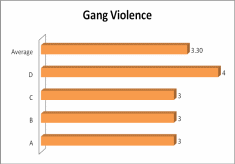
From this chart we can see that gang violence against students, teachers and staff is perceived as more dangerous than internal school violence, assuming that gang violence is external.

Other outside violence is perceived as even more dangerous than gang violence., possibly including individual attacks in the neighborhood, purse snatchings, fights or robberies. This seems odd for Hong Kong, since penalties are quite high.

The possibility of terrorism, such as kidnapping or hostage taking is perceived as extremely as very dangerous, probably because these schools attract the children of affluent expatriates, and the possibility that the violence is political in nature increases the possible harm.
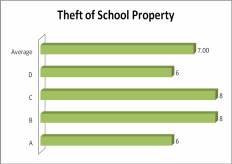
Theft of school property is not considered a danger. This may be culturally related, since school property is usally also government property, so incidence is also low.
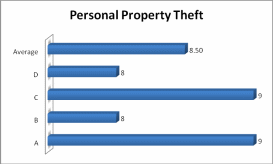
Personal property theft is also considered as low danger. Theft is simply not considered dangerous.
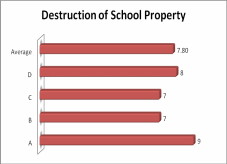
Destruction of school property is seen as more an expression of anger or lack of respect which is never spoken. This may increase the perception that it is more dangerous than theft. Also, destruction of some school property, such as safety devices, alarms and furniture can actually pose dangers.

This kind of violence is seen as more of a danger most other possibilities, but less than the threat of terrorism or other types of violence. Perhaps the students are seen as more disciplines and less likely to do real harm, even when they explode. Maybe the security people are taking into account the unlikelihood that students can obtain as many dangerous weapons in Hong Kong as in other places.
Please rate the following possible threats for which measures have been taken according to your perception of the possibility of occurrence they represent for your school by numbering them from most possibility of occurrence to least. You should consider for this question only the possible level of occurrence and not the possibility of its harm. Use the number 10 for the most occurrences and each lower number will represent a lower possible level of occurrence. (This question was also flawed in that the numbering values were reversed. The interviewer had to clarify the values.)
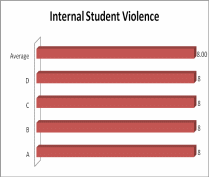
It seems that the security personnel see high occurrences of internal student violence upon students. Since these were interviews the interviewer clarified the numbering system to make sure this was the perception.
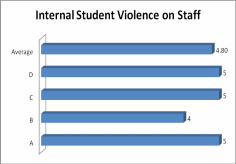
Again the security professionals agreed that the incidence of student violence upon teachers or staff was of medium occurrence, neither often nor rare.
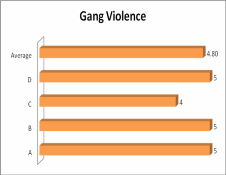
The incidence of gang violence is seen as the same level as internal violence by students on teachers or staff. This could be accounted for by very low numbers of both, making them equally as likely. Since internal violence upon teachers and staff is dealt with rather severely, this is likely. Gang violence against students, teachers or staff.

Other forms of outside violence are perceived as less likely. These might include fights, purse snatching and robbery.
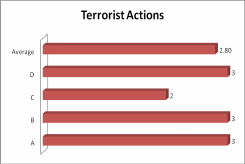
Terrorist actions are perceived as slightly more likely than other outside violence, but less likely than gang violence. Still the numbers are low, indicating less concern.
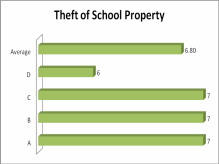
The perception of the level of theft of school property is higher than the levels for actual violence, even gang violence, so this is clearly a problem, but not a safety issue.
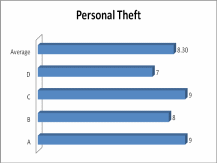
The perception is that personal theft from students, teachers or staff is quite high on a scale of 1-10. However, in the previous question we saw that it is not seen as dangerous.
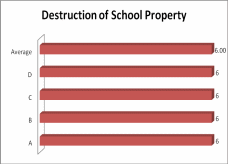
Destruction of school property is seen as a problem of more than median occurrence, but was not seen as dangerous in the previous question.
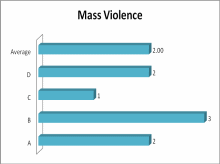
There is more difference in the responses to this question than the others. Even so, all the responses are in the lower third, and the average is only 2 of 10, a 20% chance is perceived. : Please rate the effectiveness of the following security measures for protection of students, teachers, staff and property on a scale of 1-10, with 10 being the most effective and 1 being the least effective. Are they Implemented in your school?
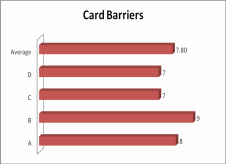
These are perceived as very effective on a scale of one to ten. However, they are not implemented in any of the schools.
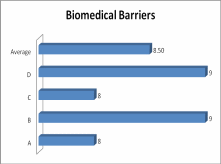
These are perceived as very effective on a scale of one to ten, even moreso than entry card barriers. However, they are not implemented in any of the schools..2 : Barriers requiring biomedical devices, such as retinal scan, voice scan or fingerprint for entry into the school.
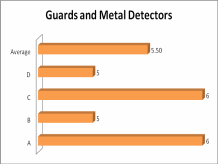
These measures are seen as less effective than either card or biomedical barriers, but even these are not implemented in any of the schools.
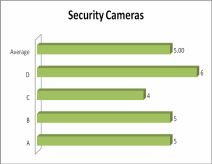
Security cameras are seen as having a medium effectiveness and are implemented in all the schools of the security personnel interviewed. This question might have been more informative if more details were acquired on this.
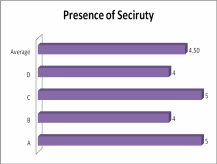
The simple presence of security is seen as having less than median effectiveness, but they are present in all the schools of the interviewees.
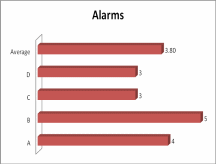
Alarms are seen as having little real effect upon safety, but they are implemented in all the schools of the interviewees.
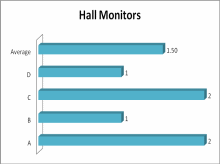
Hall monitors are seen as almost completely ineffective and are not implemented in any of the schools of the interviewees.

Guard dogs are seen as having almost no effect and are not implemented in any of the schools of the interviewees.
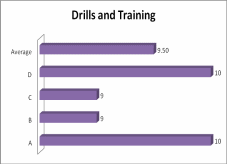
These are seen as very highly effective measures for safety. However, they have only been implemented in one of the four schools of the respondents. This seems a little strange, considering that the cost of this would be low.

Educating staff and students is perceived across the board as completely effective for safety measures, but it is implemented only in one school, the same one which implemented training and drills.
5: Does your school’s security plan include drills?
This question checks the accuracy of question 4.9, in case it was not clear. The answers were the same: three schools had not implemented drills and one had.
6 : Are there supplies on hand for medical triage? That is, is a comprehensive medical kit on hand and are there people trained to use it on hand all the time?
All four security specialists said their schools did have a comprehensive medical kit and someone trained to use it at all times.
7 : How close is the nearest hospital? (Minutes)
- 20
- 30
- 15
- 15
From these responses, the hospital is between 15 and 30 minutes away from each school. What was not asked was how long it would take an ambulance to arrive. Hong Kong has severe traffic problems. However, this is considered to be acceptable.
8: If you could add more measures for your school, what would they be?

The answers to the last question were very interesting. Even though training and drills were perceived as highly effective safety measures, none of the three security specialist from schools which had no training or drills suggested they wanted them. Three of the schools would like access controls installed and the fourth one would like a 24 hour digital recording system.
Conclusions from the Interviews of Security Managers
From the interviews with security managers at four of Hong Kong’s international schools, some surprising information was uncovered. The perceptions of security managers at the schools as far as the relative danger of different occurrences, from theft to violence by gangs or other outsider or terrorist attacks or take-overs in the schools are different than those of parents.
Security managers believe that their schools are very safe. However, they would like to see more training and drills and have more equipment. It is the perception of security managers that theft and internal violence, such as bullying, are a problem, but not a danger. They perceive the most risk for students from outside sources, except that the managers rated the danger and likelihood of internal mass violence, such as the shooting at Virginia Tech (FOXNews.com 2009), as more danger than an actual terrorist attack.
Conclusions from Both Primary Research Projects
From the survey responses of parents we see that they consider Hong Kong school safety as better than do the security managers. However, they also see the risks from different sources as more dangerous, for example bullying, which is part of violence of students against students. Security personnel would like to see much more training and drills for safety, but this was not their primary concern. Access control was considered as an effective and affordable measure which has not been implemented in any of the schools.
The interviews with security managers confirmed the opinions of the 75% of parents who were less than sure that the measures in their children’s schools were adequate as shown by responses and by those who declined to answer. What the parents do not seem to know is that these security managers have a plan and would like to do more. One of the schools even includes drills for staff and students. The specialists rated the safety of their schools very high, higher than did parents, but all would like to have more equipment and training.
The parents perceive that terrorist attacks as more likely than a shooting attack by one or more students, while security specialist felt just the opposite. This may be because parents consider outsiders more dangerous than other students, possibly friends of their children. However, it may be that mental health problems carry a stigma, so parents want to ignore such possibilities. Considering the high rate of suicide in the early years of university on the mainland and the higher than acceptable rate in Hong Kong, this is more of a possibility than parents may want to admit.
Parents feel that they do not have full disclosure, and they do not know about the implementation of security measures in their children’s schools, so maybe they are right. They are not aware that there even is a team with a security plan. What is clear from the combination of parent surveys and interviews with security personnel is that parents are more fearful than the security managers, but security managers would like more.
Conclusions from the Combined Research
In consideration of the information from the literature review and the information obtained from the primary research, it is clear that the perception of school safety by parents of students in international schools of Hong Kong schools less than accurate in that they are less informed than would be optimal, less involved in planning school safety and possibly too influenced by international news media. In the international arena, school which attract children of expatriates are targets for terrorism. In addition, since these students are generally from rather affluent families the schools and the students can become targets for crime.
Security specialists who were interviewed believe that their schools are not using the best methods to insure safety, even though they give high ratings for the current safety situations in those schools. In the event that the environment changes in the future, the measures currently in use are considered inadequate.
The literature shows that school violence is more reported than before, and possibly on the rise in reality. However, the ratio of violence to the possibilities for violence is extremely small, Many millions of students attend school around the world every day in complete safety. The percentage of actual danger is a fraction of 1%. However, when we talk about odds, we can bet them in gambling and lose money, bet them in taking a test and maybe fail or bet them where lives are concerned and someone dies. You can retake a test, recover the money, but nobody can bring back a life. Taking chances with even one of our students is unacceptable.
It is clear from the literature and the interviews with security managers that Hong Kong international school safety could be improved with very little actual cost by simply implementing drills and doing some training. In addition, some expenditure for access control would greatly increase the safety in these schools. One manager mentioned that the addition of a 24 hour security camera system would increase safety in his school. While adding new technology is expensive, the benefits could be priceless. At the very least, every school should have a plan, training and drills to increase the safety and emergency response levels.
Potential Barriers to Implementation of Risk Management Programs
In reading through all the information there are several barriers to implementing a good safety program that were discovered:
- Financial: many school district may not have the money for the technology. However, the training and drills are nearly free.
- Cultural: It is possible that people in some cultures may not want to admit that there is any possibility of violence in their schools.
- Resistance from administrations or parents: This may stem from pure ignorance as to the reality of today’s world.
- Technological: In some places in the world the technology is not available. These places, however, are usually at lower risk of violence in the schools. This does not hold true for some places in Africa, South America and the Middle East.
- Political: Some political ruling classes will not admit that there is any violence in their schools. After all, all their citizens are happy!
What Should be Done?
It is clear that more publicity for the reality is needed so that awareness is raised among educators, administrators, parents and leaders. Once awareness is raised, then solutions can be planned. Some educational programs might even be integrated into the curriculum. Parents need to become more involved in the planning in the schools of their children and be ready to contribute time and money to make the situation better.
The Lessons Learned and Suggestions for Future Research
The literature on this subject is vast, yet there is not yet a compendium of resources where people can easily find it and sort through the available literature for what they need to know. There were flaws in the primary research for this project, mostly the wording of the questions which left too much detail out and inconsistent numbering methods for responses. Some questions used 1 as low and some used it as high. This could be confusing. In addition, in some instances, it was illogical. For example, more incidents should be a higher number or higher risk should be a higher number.
More research is needed on the actual efficacy of the various possible methods for security planning. In addition a campaign should be devised in many municipalities to raise awareness of school safety issues. I believe this is true of Hong Kong. We tend to judge others by ourselves and in Hong Kong we have long been a hub of travel and commerce, so we see the world from that perspective. While Hong Kong citizens have strong ideas concerning rights and policies, we are not particularly political, so that makes us less aware of the strong motivation for violence that politics can provide. That we live in a largely peaceful place does not make us immune to violence, so we need to do something about this.
Acknowledgements
A project such as this would be incomplete without thanking all those who helped me make it possible.
Studies of this nature would have been impossible without the continuous support and patience of Mr. Tony Ma, my dissertation supervisor. I would like to express my deepest gratitude for his dynamic guidance and help through this process, and for keeping me focused on my research. His thoughtful queries, observations and comments have worked as triggers to some key insights and analyses.
I also wish to thank my employer, Hong Kong International School, and my supervisor Mr. Patrick Hall, Director of Facilities Management Department, for encouraging my topic selection and allowing me to use the resources of my workplace for research and reference material.
Finally I wish to thank the many participants who contributed their time to respond to questionnaires or interviews for the primary research.
Appendix A: The Security Questionnaire
Declaration
I am working on my Research Paper regarding Awareness of Risk Management for the Security of International Schools in Hong Kong. All information collected from this questionnaire will only be used for my academic research purposes. No personal information will be used at all.
Ratings
Please tick ONLY one box for each of the questions.
From 1 to 5; 1 – Strongly Disagree; 5 – Strongly Agree
Questions
- School is a safe place for kids to learn.
- Around the World
- In Hong Kong
- School has lower risks for Security.
- Around the World
- In Hong Kong
- Violence never happens in school
- Around the World
- In Hong Kong
- Terrorism has a large negative impact on school
- Around the World
- In Hong Kong
- Risk Management for security is important to have in schools
- Around the World
- In Hong Kong
- Security measures are sufficient in my children’s schools
- My children’s school notifies me when any incident relating to security problems occur.
- My children’s school has a risk management team evaluate the potential risks in school to
- Please rate the potential risks you estimate in schools around the world and order the factors listed below ranging from the highest risk to the lowest. That is, how high do you estimate the risk of these things happing in your children’s school. (1 is the highest 7 is the lowest)
- Terrorist Attack s
- Guns or Shootings
- Vandalism
- Bullying
- Drug Use
- Assault
- Theft
- Please rate the potential risks you estimate in schools around the world and order the factors listed below ranging from the highest importance for control to the lowest. (1 is the highest 7 is the lowest)
- Terrorist Attack
- Guns or Shootings
- Vandalism
- Bullying
- Drug Use
- Assault
- Theft
- Thank you for taking your time to participate in this research.
Appendix B
Interviews With Security Professionals
This interview is designed to identify the attitudes and perception of security professionals in the schools as to the preparedness of the school, the level of security and the effectiveness of various measures. Since is unlikely that security personnel will want to discuss the exact security measures in place the questions concern their perception of the current level of safety in the school and their opinions of different possible measures.
-
- On a scale of 1-10, with 10 being the highest, please rate the safety level of this school for students, teachers and staff.
- Please rate the following possible threats for which measures have been taken according to your perception of the danger they represent for your school by numbering them from most harm represented to least. You should consider for this question only the possibility and possible level of harm and not the possibility of its occurrence. Use the number 1 for the worst and each higher number will represent a smaller possible level of harm.
- Internal violence of student (s) upon student (s)
- Internal violence upon teachers or staff by students.
- Gang violence against students, teachers or staff.
- Other outside violence against students, teachers or staff.
- Terrorist actions, such as kidnapping or hostage taking.
- Theft of school property.
- Theft of personal property of students, teachers or staff.
- Destruction of school property.
- Mass attacks of the same type as occurred at Columbine and other North American schools.
5. Please rate the following possible threats for which measures have been taken according to your perception of the possibility of occurrence they represent for your school by numbering them from most possibility of occurrence to least. You should consider for this question only the possibility and possible level of harm and not the possibility of its occurrence. Use the number 1 for the worst and each higher number will represent a smaller possible level of harm.
- Internal violence of student (s) upon student (s)
- Internal violence upon teachers or staff by students.
- Gang violence against students, teachers or staff.
- Other outside violence against students, teachers or staff.
- Terrorist actions, such as kidnapping or hostage taking.
- Theft of school property.
- Theft of personal property of students, teachers or staff.
- Destruction of school property.
- Mass attacks of the same type as occurred at Columbine and other North American schools.
6. Please rate the effectiveness of the following security measures for protection of students, teachers, staff and property on a scale of 1-10, with 10 being the most effective and 1 being the least effective.
- Barriers requiring an entry card to enter the school.
- Barriers requiring biomedical devices, such as retinal scan, voice scan or fingerprint for entry into the school.
- Limited guarded entry with metal detectors.
- Security cameras.
- Simple presence of security personnel.
- Alarms.
- Hall monitors.
- Guard dogs.
- Drills and training with personnel.
- Student and staff education.
7. Yes_____ No_____ Does your school’s security plan include drills?
8. Yes_____ No _____ Are there supplies on hand for medical triage? That is, is a comprehensive medical kit on hand and are there people trained to use it on hand all the time?
9. How close is the nearest hospital?
10. If you could add more measures for your school, what would they be?
Thank you for your participation. No names will be used, and the identity of the school will not be shared.
References
Applied Risk Management, 2008, Campus Violence Prevention and Response: Best Practices for Massachusetts Higher Education; Report to Massachusetts Department of Higher Education
Arto, K. A., 2000. PMI Seminars & Symposium. Proceedings, 2000, 20190, (2000 : Houston, Tex.), PMI Seminars & Symposium, Newtown, PA
Austin, Thomas L. & Bumphus, Vic W. (1998), Arming The Campus Cops: A Descriptive and Multivariate Assessment Of Support, Journal: Policing, An International Business, Vol 21. Issue 2, pp.255-268, Emerald Journals on Line
BBC News, 2009, Probe into Canada College Attack.
Borum, Randy; Fein, Robert; Vossekuil, Bryan and Berglund, John, 1999, Threat Assessment: Defining an Approach for Evaluating Risk of Targeted Violence, Behavioral Sciences and the Law, Behav. Sci. Law 17: 323±337, Wiley
Bowen, Peter J. and Bowen, Paul A. (2005), Risk Management in Project Organizations, First Edition, Butterworth Heinemann
Conrow, Edmund H. Ph.D., (2003), Effective Risk Management: Some Keys to Success, Second Edition, American Institute of Aeronautics and Astronautics (AIAA)
Cornell, Dewey G. (2003), Guidelines for Responding to Student Threats of Violence, Sopris-West Educational Journals, Virginia Psychological Association
Davies, Hilary and Stevens, Christopher, (1993/1994), Vandalism: Risk Assessment for Schools, Structural Survey, Vol.12, Issue 3, pp. 4-7
Debarbieux, Eric; Segalen Bordeaux 2, Bordeaux, and France (2003), School violence and globalization , Journal pp.583-584)
Fishe, Bonnie S. ( 1995), Crime and Fear on Campus. The ANNALS of the American Academy of Political and Social Science, Vol. 539, No. 1, 85-101, Sage Journals online
Fortin, Laurier , (2003), Students’ antisocial and aggressive behavior: development and prediction, Journal of Educational Administration Vol. 41. Issue 6
FOXNews.com , 2009, Federal Officials: At Lease 32 Dead After Virginia Tech University Shooting. Web.
Frick, Paul J. 1998, Conduct Disorders and Severe Antisocial Behavior , illustrated, Springer, Web.
Garb, H. N. (1994). Toward a second generation of statistical prediction rules in psychodiagnosis and personality assessment. Computers in Human Behavior, 10, 377±394.
Grove, W., & Meehl, P. (1996). Comparative efficiency of informal (subjective, impressionistic) and formal (mechanical, algorithmic) prediction procedures: The clinical±statistical controversy. Psychology, Public Policy and Law, 2, 293±323.Gorman, Kevin and Pauken, Patrick, (2002), The Ethics of Zero Tolerance, Journal
Henry, Stuart T1 What Is School Violence?: An Integrated Definition JF The ANNALS of the American Academy of Political and Social Science JO The ANNALS of the American Academy of Political and Social Science YR 2000 FD VO 567 IS 1 SP 16 OP 29 DO 10.1177/000271620056700102
Holmes, R., & Holmes, S. (1996). Pro®ling violent crimes: An investigative tool. Thousand Oaks, CA: Sage.
ISO 31000, 2009, “Risk management — Guidelines on principles and implementation of risk management”(2007)
Lambert, Regina D. and McGinty, Dixie (2001), Law Enforcement Officers in School: Setting Priorities, Journal of Educational Administration, Vol 40, Issue 3
Olsson, Rolf (2008), Risk management in a multi-project environment: An approach to manage portfolio risks, International Journal of Quality & Reliability Management, Vol. 25, Issue 1
O’Neill, Daniel; Fox, James Alan Ph.D.; Depue, Roger Ph.D., & Englander, Elizabeth Ph.D. (2008), Campus Violence Prevention and Response: Report to Massachusetts Department of Higher Education
Parker, David and Mobey, Alison, (2004), Action research to explore perceptions of risk in project management, International Journal of Productivity and Performance Management, Vol. 53, Issue 1, pp. 18-32
Shaw, Margaret, 2001, Promoting Safety in Schools: International Experience and Action, Series: Monograph (6 x 9), Bureau of Justice Assistance
Simister, T. ( 2000), Risk Management: The Need to Set Standards, Emerald Management Reviews Database , Vol. 8, Issue 4
Smith, Page A. , (2005), The Organizational trust of Elementary Schools and Dimension of Student Bullying, International Journal of Educational Management Vol. 19, Issue 6, pp. 469-485
Tchankova, Lubka, (2002), Risk identification: Basic Stage in Risk Management, Environmental Management and Health, Vol. 13, Issue 3, pp.290-297
The Hong Kong Federation of Youth Groups, (2009) eNewsletter, Issue 24, 2004
Trunp, Kenneth, 2009, National School Safety and Security Service,
Wang, John X. and Roush, Marvin L., 2000, What Every Engineer Should Know about Risk Engineering and Management, Edition: illustrated, CRC Press, p 137
Werthein, Jorge, (2003), Tackling Violence in Schools: the Role of UNESCO/Brazil, Journal of Educational Administration, Vol 41, Issue 6, pp.603-605
Wikipedia, the free encyclopedia.